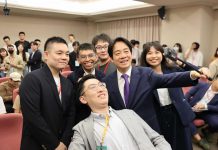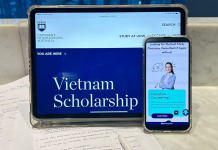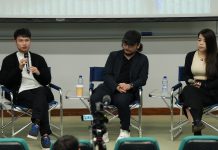Yeung wore his hair long and treated his students like friends, which he says made him stand out as a “black sheep” in the Christian school. Being unmarried and without children, he could spend every day with his students and sometimes visited their homes to understand their family situation. When he met them outside of school on weekends, he did not stop them from smoking or swearing. His non-judgemental attitude won him the students’ trust. “They were close to me, and when they are close to me, that is when education starts,” he says.
Rather than becoming artists, Yeung hoped to educate his students to be citizens who care about society. “I want to teach more [students to be] Joshua Wong Chi-fung,” he says.
Therefore, Yeung combined the teaching of art with engagement in society. He introduced artworks related to social issues and encouraged his students to try incorporating social elements in their work. Under his influence, his students became concerned about society and expressed their feelings on particular issues through art. For instance, one student satirised national education as brainwashing students by turning his bedroom into an installation, which included a national flag blanket, Mao Zedong’s portrait, and Cultural Revolution slogans and posters.
Yeung did not just talk about politics in the classroom, he also took his students to observe social movements. In 2010, he took 18 students to the protests outside the Legislative Council against the Guangzhou-Hong Kong high-speed project. He was moved to tears when six of them volunteered to take part in a barefoot protest walk, prostrating themselves every few steps to express their opinions in a peaceful and humble way.
Beyond social movements, Yeung has also worked with the Arts with the Disabled Association Hong Kong for a decade and led his students to take part in community art with people with disabilities twice a year.
He once assigned his students to teach people with cerebral palsy, step by step, how to tie ribbons on the handrails of stairs. A simple action that would take the students just seconds, took those with cerebral palsy three minutes to complete. The experience surprised but also touched them. One was inspired to become a social worker, while others continued to do voluntary work at other community centres.

Yeung believes art is very powerful and can change people’s perceptions. He recalls that when he walked past a special school in 2001, he overheard a mother telling her daughter that if she did not study hard, she would be put in that school. Feeling bad about this, Yeung invited the school to join a community art project sponsored by the Hong Kong Institute of Education (now the University of Education). He assisted students with mild mental disabilities and their teachers to paint using different methods.
After three months, all the works were displayed at the main entrance of the school. The school’s neighbours reacted in a positive way and the project helped to change the school’s image.
“People classify [people with disabilities’] abilities as being high or low. We shouldn’t classify it that way. Their abilities are merely different,” Yeung says. Instead of seeing himself as teaching students with mild mental disabilities, he says they have actually taught him to understand their committed attitude and ability to concentrate.
Yeung says the students can understand what to do if he explains it to them clearly and slowly. What is more, they have their own creativity and painting styles. He admires their ability to express their feelings through their paintings without any burdens and says he could never imitate them.

Despite retiring in 2013, Yeung still contributes to community art. Last year, he helped to curate the first graduation show of “I-dArt”, a three-year art education course for the disabled and the elderly. He volunteered to teach six lessons and observed a student with autism who always ignored his instructions. The student would just write down the names of TV programmes, celebrities, and products in every lesson. To force her to try new techniques, Yeung took away her brush and gave her rolls of tape to make the words in a different way. The student was not used to this method at first, but she smiled when she saw the finished product and was willing to try the method again next time. The satisfaction from such encounters gives Yeung an incentive to keep teaching.
From downtrodden salaryman to angry young artist to wise teacher, Yeung looks back on his life with no regrets. “I lived in hell in the first half of my life and live in heaven in the rest of my life,” he says. “Life is full of twists and turns. If I did not have those experiences, I would not know how to teach my students now.”
Edited by Venice Lai






































